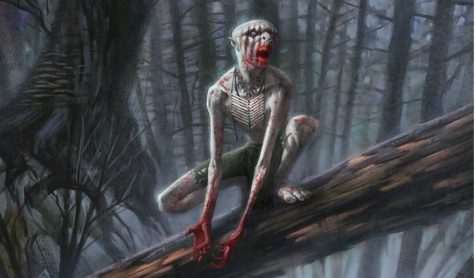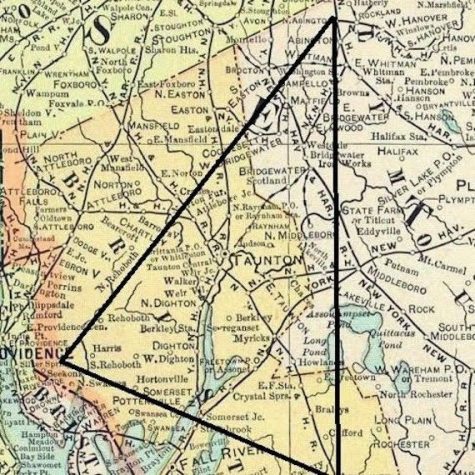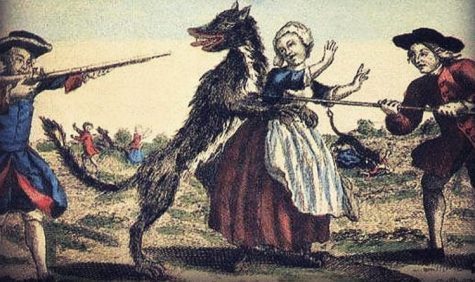Conspiracy Corner – The Witching Hour
All-hallows-eve draws near. So, come, sit closer to the campfire. The night is cold, after all, and who knows what’s on the prowl? Pull your coat tight, fix yourself some smores, and get comfortable. Soon it will be midnight – the Witching Hour – and what better time for a story? A ghost story, then, to cap off the night. A story of a haunting, a witch, and the miserable death of one John Bell...
The year was 1817. John Bell, his wife Lucy, and their children had settled nicely into their new home, having moved from North Carolina to Adams, Tennessee in 1804. Their land holds had grown significantly since they arrived over those thirteen years. As did their family with three new children: Elizabeth, Richard, and Joel. John himself had become a quite distinguished member of the community, and elder of the local church. Everything was looking bright for the family. Sadly, it would not last.
While tending his fields, John Bell spotted a strange creature. It was described as a strange hybrid, having the body of a dog but the head of a rabbit. John attempted to shoot and kill the creature, but it fled before his rifle could find its mark. Where the animal had come from or where it had gone, John could not say. It was not the only strange occurrence that the Bell family had. Shortly after, Drew, John’s son, supposedly saw an unnaturally large bird eerily watching the house, while Elizabeth saw a girl in a green dress in their backyard. The girl was swinging from a tree before disappearing as Elizabeth approached. The strange dog made repeat visits, according to a man named Dean. Dean was a slave owned by Mr. Bell who, supposedly, was stalked by a large black dog on multiple occasions.
At night, the house would be accosted with strange, eerie noises. Something would bang on the walls from the outside from dusk to dawn. The Bell family even reported hearing the voice of an old woman who would sing hymns. Sometimes, the voice would terrify the family by quoting, completely and perfectly, entire sermons that the Bells had attended in church. To add to the eeriness, these sermons were held approximately thirteen miles away from the Bell house.
The haunting would escalate to something more physical. Covers and blankets would be torn from their bed. Elizabeth informally referred to as “Betsy” in most accounts, received the worst of the attacks. She reported being struck by invisible forces, having her hair pulled, and abused so viciously that welts and bruises were left behind.
John had hoped to keep news of these odd events from leaking to the community, and possibly damaging his reputation. Yet, as the activity grew worse, he eventually relented. He approached their neighbor, one James Johnston, and told him of what was happening. Johnston was not willing to fully accept the story, nor completely dismiss his friend’s concerns, So, to settle the matter, Johnston offered to spend the night at the Bell residence. Apparently, the evening went calmly at first. That was, however, until he went to bed. Suddenly, he was awoken by the same sounds that had plagued the Bell family and would later tell John that he firmly believed a spirit was set upon his household.
Soon after, rumors of the haunting spread to the town, and people would come to see the strange occurrences for themselves. One such visitor was an anonymous Englishman who was skeptical of the spirit’s existence. However, the spirit was said to speak to the man in the voices of his parents, who were overseas in England. In the morning, he awoke to those same voices discussing how they heard his voice the night before as well. Later, the man returned home to England to discover that his parents were visited by the spirit the same night it tormented him.
Plenty more visitors would find their way to the Bell house. Yet, there is one who deserves particular attention. You see, three of John’s older sons, John Jr., Jessie, and Drew served in the United States Army, and supposedly saw action during the Battle of New Orleans in 1815. As news of the Bell haunting spread, the stories reached their old garrison commander: Andrew Jackson. That’s right, this story involves the most mentally unstable President in American history fighting a ghost. According to legend, in 1819, Andrew Jackson ventured to challenge the spirit along with several soldiers, and a wagon packed with supplies. The witch, supposedly, did not wait long to act against Jackson.
Supposedly, Jackson’s wagon came to a complete stop. The horses simply refused to move forward. “By the eternal, boys,” Jackson allegedly said, “it is the witch.”
To this, a disembodied voice replied, “All right, General, let the wagon move on. I will see you again tonight.”
Jackson and his company arrived at the house and settled in. As the evening went on, the company conversed over food and drink. One of Jackson’s men, perhaps covering fear with boastfulness or just having too much liquid courage, claimed to be a “witch layer” and having slain such spirits before. The man rambled on about different supernatural forces he encountered only for the witch to interrupt, attacking the man as she had the Bell’s themselves. Invisible hands pounded on the supposed witch hunter, and even threw him out of the house, dragging him by his nose. The spirit then threatened that she would return and expose another fraud. And while the men wished to flee the house, Jackson was resolved to spend a week at the Bell house.
We don’t know what happened over the course of that night. Perhaps the spirit did expose another fraud but, sadly, I have yet to find a source that establishes anything concretely. But we do know this: according to the legend, whatever happened that night was enough to change Jackson’s mind. In the morning, he and his men loaded up the wagon and set off for Nashville, leaving the Bell’s to their fate. Jackson, purportedly, was quoted saying, “I would rather face the whole of the British Army than spend another night in the Bell house.”
As the haunting went on, the spirit became more and more vocal – to the point that the people could converse with it. An account published in the Saturday Evening Post described it as such, “It was in the form of a voice speaking in different parts of the house. It generally, as ghosts are wont to do, manifested itself only in the night; and, if I am not mistaken, the lights had all to be put out before it would speak.”
From these conversations with the ghost, we learned a few key things. Firstly, we receive a name for the spirit: Kate or “Ol’ Kate Batts’ ghost”. This is significant because Kate Batts was a real person who had a history with the Bell’s. The Batts family was on hard times after an accident had rendered Frederick, Kate’s husband, unable to work. The Batts had to sell pieces of their land to stay afloat and John Bell bought them for far below their market price. Further on, John would swindle money by buying a slave from Frederick’s brother only to, when Frederick’s brother tried to renegotiate the price, sell the slave back to the Batts for more than he bought her.
Perhaps this grudge explains the spirit’s particular hatred for John Bell, whom the ghost called “Old Jack”. She even went as far as to say she intended to murder John and she would not give up until he was dead. Truly, the haunting was taking a physical toll on John as, even early on, he developed a paralysis of the mouth that would leave him unable to speak for long stretches of time. Eventually, he would begin to suffer major health issues and, in 1820, become bedridden. His suffering ended on December 20th. John Bell died in his bed. Supposedly, John Jr. searched the room and discovered, instead of his father’s medicine, a vial filled with a strange black liquid. At this point, the spirit spoke up and claimed to have poisoned John and saying, “He will never get up from that bed again!” To this day, John Bell is the only death in American history with the cause of death being marked as ‘supernatural’.
Soon after, John Bell Sr. was buried. Yet, even during his funeral, the spirit never ceased her hatred against him, with a disembodied voice loudly and happily singing drinking songs as the mourners wept. One can still find his gravestone in Springfield, Tennessee, buried in his family cemetery.
Slight tangent, but in 1951, John’s tombstone apparently went missing and had to be replaced with a new one in 1957. I don’t know if that was the witch or simple mismanagement by the groundskeepers, but I like to imagine that, even one hundred thirty-one years later, Kate’s ghost is still giving John Bell the business.
Moving on, the haunting did not end with John’s death. The spirit continued to harass the family. Her target now was one Betsy Bell, the daughter, over her engagement to one Joshua Gardner. Yet, this is where the story hits a fork in the road. There are two versions of what happened next: the version was written in The Saturday Evening Post and the one in Martin Van Buren Ingram’s account, An Authenticated History of the Famous Bell Witch. Since both have their merits, I figure the prudent thing to do would be to present both accounts without bias and leave it to the reader to decide for themselves.
The Saturday Evening states, “When asked how long it was going to remain, it would reply, “Until Joshua Gardner and Betsy Bell get married.” Now Mr. Gardner was a very likely young man, who resided in the neighborhood, and with whom the writer of this subsequently became well-acquainted.”
The article goes on to state that the witch was a fabrication of Betsy or, at least, used by her as a means to an end. It writes, “But the thing could not always last; the spell of enchantment was destined to be broken. It turned out that Miss Betsy Bell was a ventriloquist – had, from some circumstance become aware of the possession of such powers – had fallen in love with Mr. Gardner, and wished him to marry her – and fallen upon this plan to bring about a matrimonial union. But Joshua Gardner and Betsy Bell never married; and the ghost at length ‘vanished into thin air’ as is generally the end of all ghosts.”
I shall leave it to the reader to decide if an elaborate act of ventriloquism is enough to explain the phenomenon we’ve discussed; though I shall admit, it does seem a lackluster explanation.
The account told in An Authenticated History of the Famous Bell Witch states that the spirit had the opposite intention and hoped to prevent marriage between the two lovers. The spirit would attack and harass Betsy, repeatedly announcing that she would never marry Gardner. In 1821, Betsy officially broke off the engagement, saying she feared the witch would kill Joshua as it did her father. Shortly after, perhaps out of heartache, Joshua Gardner moved away out of the county to start anew somewhere else.
After that, the haunting seemed to fade away. The spirit declared that she would leave the house but return in seven years. According to reports, the spirit made good on its promise but the family, having grown used to it, simply ignored the spirit until it finally faded away for good.
As the spirit disappeared, the legend remained. The Bell Witch haunting became a national sensation. Yet, the legend would have fallen into obscurity over the centuries if not for the work of one man, the aforementioned Martin Van Buren Ingram. Ingram was a well-known editor for the Clarksville Chronicle, later becoming The Leaf-Chronicle which is still open to this day. He was noted to have taken several trips to the area to research the incident, even interviewing James Johnston’s granddaughter, Nancy Ayers, in 1892. In 1893, he sent the manuscript to Clarksville for publication, yet it was delayed…for a very peculiar reason. The publisher, one W.P. Titus, claimed to have been terrorized by the Bell Witch. The witch would make the publishing house’s roof shake as well as sing, moan, and make banging noises. Regardless, by 1894, the book was published under the full title: An Authenticated History of the Famous Bell Witch. The Wonder of the 19th Century, and Unexplained Phenomenon of the Christian Era. The Mysterious Talking Goblin that Terrorized the West End of Robertson County, Tennessee, Tormenting John Bell to His Death. The Story of Betsy Bell, Her Lover, and the Haunting Sphinx.
Chapter eight of the book contains a ninety-page account supposedly written by Richard Bell, son of John Bell Sr. The account, entitled Our Family Trouble, was supposedly delivered to Ingram by James Allen Bell, Richard’s son. James explained that Richard had written the manuscript, but told his son not to release it to the public until all members of John Bell Sr.’s immediate family were dead. Richard died in 1857 while his youngest brother and last immediate family member, Joel, died in 1890.
The authenticity of Ingram’s book has been called into question. Many suspected him of manufacturing the Bell Witch story whole cloth. This accusation was founded on the fact that the only source Ingram cited beyond the supposed manuscript was an article published in The Saturday Evening Post, an article which no one could prove to exist. However, this accusation has been debunked and Ingram’s name restored as, though the article itself eludes discovery, reprints of the said article have been found. Particularly, a reprint used in abolitionist newspaper The Green Mountain Freeman, with the article pre-dating Ingram’s book.
Finally, with all the history out of the way, we can move onto our speculation. So, cutting to the chase, what exactly was the Bell Witch? This seems a deceptively simple question. After all, the spirit itself claimed to be Kate Batts. Kate was known to be a rather eccentric person outcasted by the community. And though the God-fearing people of Red River did not believe witchcraft to be more than old tall tales, the word “witch” was never far from their tongues when they spoke of Kate. And she certainly had the motive to hurt the Bell family.
The case also has signs of witchcraft. Take, for instance, the black dog with the rabbit head. Black dogs are well-established in witch lore, even being reported in the testimonies given during the Salem Witch Trials. They are referred to, by those in the know, as “familiars”. Familiars are spirits – typically demons – who pledged themselves to a witch and take the form of animals. These animals can be normal-looking or can be freakish hybrids, like the man-faced rat Brown Jenkin from H.P. Lovecraft’s Dreams in The Witch House. Perhaps Kate sent this familiar spirit to harass the Bell family? Witches have also been known to send their own apparition out to wreak havoc, explaining Kate herself being the spirit haunting the house.
Yet, consider this, the entity did not name itself as Kate but simply responded to the name when referred by such. Is it not possible that the spirit could have agreed to the name as a way to throw the blame onto a living person and perhaps sow more discord in the community? Beyond that, the spirit often changed its story as to its origins. Apart from being Kate Batts, the spirit also claimed to be the vengeful ghosts of Native Americans buried on the land the Bells had settled on.
One account states that the spirit haunting the Bells was not Kate or even a witch, but the ghost of a slave driver John had shot during an argument back in Carolina. Known for his fiery temper and cruel nature, the slave driver’s death was marked as self-defense, and John, acquitted, soon after moved to Tennessee. However, the Kate theory has one thing the slave driver doesn’t: a name. Nowhere in the account is a name given for the murdered man, even though records of a murder trial for such a prominent man as John Bell should be easy to find.
For the skeptics among us, another theory posits that there was no Bell Witch. Some believe that the entire story was a hoax concocted by Lucy Bell. Why? Because she was the one poisoning John Bell with the black vial and the Bell Witch was simply a cover story. I, however, find this hard to believe. With the sheer number of people going through the house who had seen or spoken to the Bell Witch, it would be almost impossible for Lucy to fool them all. Especially the Englishman previously mentioned. How would Lucy mimic his parents’ voices? Or manage to somehow pull the same trick on his parents while an ocean away? Beyond that, a motive for this overly elaborate murder is never stated. On the other hand, I would not discount the possibility that Lucy did indeed kill her husband in the hopes that his death would end the haunting. Desperate people do desperate things.
In the end, we will likely never know the true nature of the Bell Witch haunting. Centuries later, the descendants of the Bells and Batts families still seek answers or, if nothing else, to keep the story alive. And while the Bells seem to sleep cozy in their graves, the witch still stirs. Strange noises and mysterious happenings are still reported to this day by those living near the property – especially near the mouth of a strange cave since named “The Bell Witch Cave”.
But alas, my friends, our tales have drawn to an end. Better yet, it seems the Witching Hour has passed. The dark things of the world creep back to their hollows and covens retire for the night. We should do likewise. Although, I bid you join us on the 28th of October. As Samhain approaches, we here at Conspiracy Corner have something special up our sleeves: THE HALLOWEEN SPOOKTACULAR! So, join us for tricks and treats and a special article of Conspiracy Corner!
Until then, stay safe and have a happy October!







